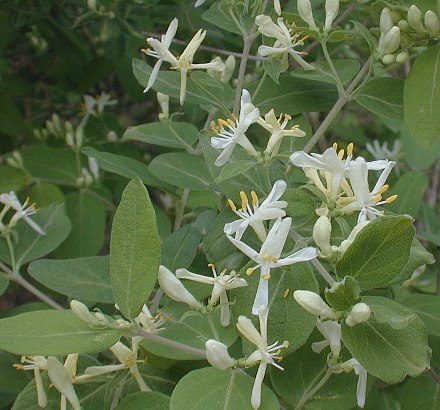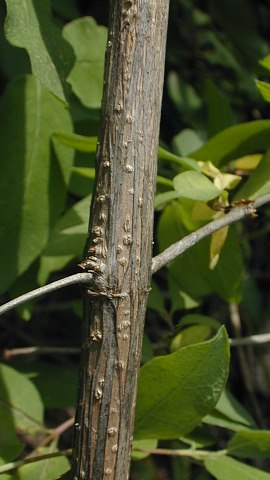Description: This woody shrub is about 6-10' tall and much branched. Young branches are terete, pubescent, and gray-colored. Older branches become covered with bark that develops shallow longitudinal fissures; this bark is typically greyish brown. Along the smaller branches and twigs there are pairs of opposite leaves. The blades of these leaves are about 2-3" long and ¾–1" across; they are oblong-ovate or oblong-lanceolate with blunt tips and rounded bottoms. Their margins are smooth. During the spring, the upper surfaces of these leaves are dull greyish green, while their lower surfaces are greenish white from a dense short-pubescence (see photograph of Leaf Underside). Later in the year, the upper surfaces of these leaves become medium green. The slender petioles of the leaves are up to 1/3" (8 mm.) long.

Pairs of flowers
develop from the axils of the leaves on pedicels up to ½" long. The
corollas of these flowers are initially white, but they later become
cream-colored. The corolla of each flower spans about ¾–1" long and
across; it divides into 5 widely spreading slender lobes from a narrow
tubular base. Exerted from the throat of each flower, there are 5
stamens and a single style with a globoid stigma. The anthers of the
stamens are yellow, while their filaments are white. The tubular calyx
of each flower is greyish green and pubescent with five teeth; it is
very short. Underneath each calyx, there are small blunt bractlets and
a pair of narrow leafy bracts. The blooming period occurs during mid-
to late spring and lasts about 3 weeks. The flowers are very fragrant.
The ovary of each flower matures into a globoid red berry about ¼"
across. Mature berries are juicy with a flavor that is bland or
slightly bitter. Each berry contains several yellow seeds (up to 3 mm.
long) that are ovoid and somewhat flattened in shape. The root system
is shallow and woody. This shrub spreads by reseeding itself.

Cultivation:
Morrow Honeysuckle prefers full sun to light shade, moist to slightly
dry conditions, and soil containing fertile loam or clay-loam. It may
also adapt to soil that is gravelly or sandy. This attractive shrub is
easy to grow, but it can invade natural habitats.
Range & Habitat:
Thus far, the introduced Morrow Honeysuckle has been collected from
only a few
counties in east-central and northern Illinois (see Distribution
Map). However, this shrub is more common than these records
indicate and it is undoubtedly still spreading. In Illinois, habitats
include deciduous woodlands, savannas, woodland borders, thickets,
fence rows, urban vacant lots, and overgrown areas along railroads and
roadsides. Morrow Honeysuckle has an affinity from disturbed woodlands
with young trees. It is able to displace native shrubs and casts a
dense shade that can kill off most of the ground flora, including
spring wildflowers in woodlands. Morrow Honeysuckle develops its leaves
earlier in the spring than other shrubs and it retains its leaves later
in the fall. This shrub is native to East Asia.
Faunal Associations:
The flower nectar of honeysuckle shrubs and vines attracts the
Ruby-Throated
Hummingbird and Sphinx moths (particularly Hemaris thysbe
& Hemaris diffinis); other insects that may
visit the flowers include Swallowtail butterflies, Anthophorid bees (Anthophora
spp.), and bumblebees. Several insects feed on honeysuckle
shrubs and vines. This includes the caterpillars of the moths Alucita
adriendenisi (Six-Plume Moth sp.), Callizzia amorata
(Gray Scoopwing), Harrisimemna trisignata (Harris
Three-Spot), Hemaris diffinis (Snowberry
Clearwing), Hemaris thysbe (Hummingbird Clearwing),
and Ypsolopha dentella (Honeysuckle Moth). Also,
the later instars of the butterfly Euphydryas phaeton
(Baltimore) occasionally feed on honeysuckle leaves. Other insects that
use honeysuckles as a food source include Agrilus
cyanescens (Metallic Wood-Boring Beetle sp.), Hyadaphis
foeniculi (Honeysuckle Aphid), and Zaraea inflatus
(Honeysuckle Sawfly; syn. Zaraea inflata). While
all of these insects have been found in various parts of northeastern
United States, some of them have not been found in Illinois thus far.
In addition, some of these insects may not feed on non-native
honeysuckle shrubs.
The berries of these shrubs are eaten to a limited extent by
various species of songbirds (see Bird Table). Because these berries
are relatively low in protein and fat, they are not popular as a food
source.
White-Tailed Deer occasionally browse on the foliage and smaller
branches.
Photographic Location:
Along trails at Busey Woods in Urbana, Illinois.

Comments: Morrow Honeysuckle is one of several honeysuckle shrubs that have been introduced from Eurasia. Many of these species are highly invasive of natural habitats; among the worst offenders in the Midwest are Lonicera maackii (Amur Honeysuckle), Lonicera morrowii (Morrow Honeysuckle), Lonicera tartarica (Tartarian Honeysuckle), and Lonicera × bella (Showy Honeysuckle). The latter is considered a fertile hybrid of Morrow Honeysuckle and Tartarian Honeysuckle. Compared to these other shrubs, the leaves and young branches of Morrow Honeysuckle are more pubescent (particularly during the spring). Its leaf blades tend to have more rounded bottomed and blunt tips; the leaf blades of other Honeysuckle shrubs have more acute tips and/or their bottoms are more cordate (slightly indented). Both Tartarian Honeysuckle and Showy Honeysuckle have flowers that are often pink or pink-tinted, while the flowers of Morrow Honeysuckle are consistently white (and later cream-colored). Amur Honeysuckle has pairs of berries that are nearly sessile against its branches, while the berries of Morrow Honeysuckle have pedicels about ½" long. An alternative spelling of the scientific name for this species is Lonicera morrowi.